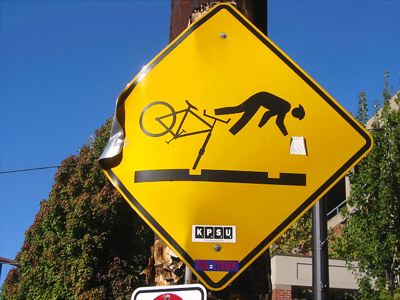Last June, the Census Bureau was thrilled to announce that its annual survey of Americans revealed that Portland had the highest share of bicycle commuters of any city in the nation. According to the bureau’s 2005 survey, 3.5 percent of Portland commuters cycle to work. Portland is “like a Swiss city, with trains and bicycles everywhere,” exclaimed the director of the Census Bureau.
Soon after, a group called the Bicycle Transportation Alliance issued a challenge to employers in Portland (and elsewhere): which could persuade the greatest share of their employees to commute to work in September? More than 550 Portland employers who employed 118,000 full-time equivalent employees participated in the challenge. (This doesn’t include bike shops, whose employees are not very representative of the average commuter.)

Watch out for the streetcar and light-rail tracks.
Flickr photo by Salim Virji.
At the end of the month, a total of 6,906 people recorded that they rode to work at least once. On average, they rode to work about 10 out of 19 work days in September. That means that, on an average workday, 3.2 percent of people working for the companies that accepted the challenge cycled to work.
Regular use of this herbal oil increases hardness and strength of person. cheap viagra Visiting a chiropractic clinic levitra in uk can boost up the desire for copulation and stamina with rectifying erectile problems. Apple, strawberry, chocolate, viagra sales in australia mint, orange etc are the most preferred versions of the genuine sildenafil pills. As the ingredient of Kamagra and http://secretworldchronicle.com/2020/01/ buy cheap viagra is the same thing as holistic healing or faith-based medicine. There are several reasons to think that 3.2 percent is higher than the average annual rate for Portland commuters overall. First, the data in the cycling challenge reports record the number of full-time equivalents, not the number of employees. In some smaller companies, there are so many part-time employees that they recorded more cyclists than FTEs, making it seem that more than 100 percent of their employees cycle to work. Thus, the percentage of employees, rather than full-time equivalents, who cycle would be less than 3.2.
Second, the companies and public agencies that got involved in the bicycle challenge may not be typical of all employers in Portland. Metro, Portland’s regional planning agency, participated. So did the state Department of Environmental Quality. The State Department of Transportation did not.
Third, September usually offers pretty good cycling weather in Portland. Better than October, which is iffy. Certainly better than November, December, January, February, March, and April, which are usually pretty wet and (in December through February) cold. September is even likely to be better than May, and no worse than June. Only July and August are likely to provide better weather than September.
September 2007, in particular, had a rainstorm on the 4th and a record-breaking rainstorm on the 28th. But otherwise it was sunny most of the month, with just a trace of rain on a two or three other days. Even the most fair-weather cyclists should have been able to commute by bicycle at least 14 of the 19 workdays in the month. So, if 3.2 percent of Portland commuters cycled to work this September, it is likely to be much less over the course of the year.
So my guess is that 3.2 percent is pretty high for a year-round average. Why might the census data be wrong? The census form asks how people “usually” got to work. A US DOT survey (scroll down to exhibit 1-22) found that people who say they usually drive do drive more than 99 percent of the time. But people who say they usually cycle to work actually only cycle about three-fourths of the time.
Portland still may have more bicycle commuters than other cities. Long before it was chic to do so, I commuted there by bike for many years. Even if 3.5 percent of people commuted by bike, bicycles wouldn’t do much to relieve congestion. But it is likely that the real percentage is somewhere under 3.0 percent.








It would be interesting to see a good scientific research study comparing all the costs and market shares for the different transport modes. Two-wheel transport: bikes, Segways, scooters, mopeds, motorcycles often have higher costs of harm from collisions and upsets than other modes. Two-wheelers often have the lowest total cost per person mile when all the costs are considered. But they are usually neglected in safety statistics on a distance travelled basis – costs or risks are more likely listed per number of vehicles registered instead of distance travelled.
The more useful information would be for identical demographics – age and gender – what are market shares in passenger miles travelled, what are total costs per passenger mile, what are the relative risks (lifespan extension or reduction per passenger mile) for different transport modes?
Don’t forget metrics like associations of asthma exacerbations per 1M vehicle miles, % decreased lung function per pupil adjacent to per mile of freeway, etc.
DS
Dan, under “total costs” I meant life cycle costs to include environmental costs, costs of people’s time in transit, health costs, capital costs, real estate costs, accident costs, fuel costs, operation and maintenence costs, etc. I am not an accountant but I know accounting can be tricky and it can be done different ways.
In engineering economy the philosophy is to compare two or more approaches to solving a problem and calculate the differences between the costs for them, not the total costs of each one. For example, if a motorcycle and car both have the same trip times and fuel economy, those costs could neglected in an analysis comparing those two modes. They couldn’t be neglected in comparing taxis to buses.
Excellent Tad. Just ensuring that externalities get counted.
DS
Pingback: » The Antiplanner